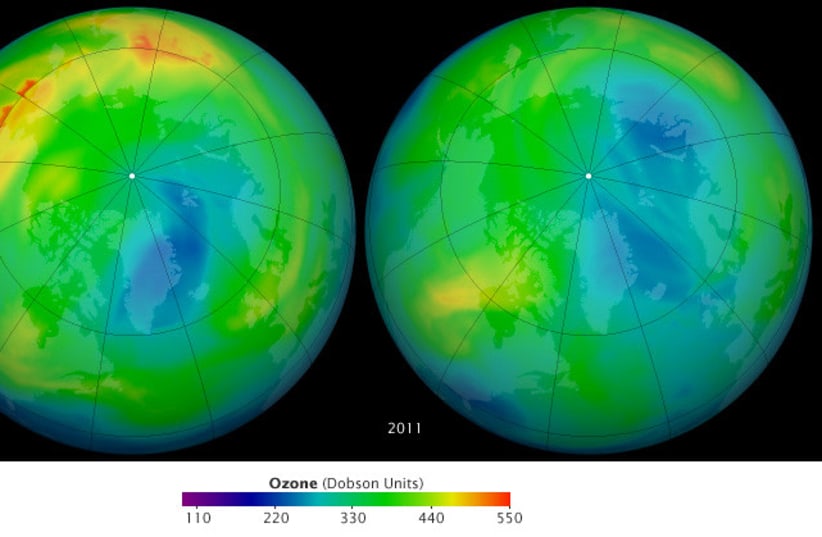Efforts to lower the use of ozone depleting substances have succeeded, with the ozone layer healing and the Earth expected to avoid 0.5-1C of global warming, according to a new report compiled by hundreds of scientists around the world on Monday.
The ozone layer, compiled of O3, reduces the amount of harmful UV radiation that reaches the Earth's surface. A group of substances called chlorofluorocarbons (CFCs), commonly used in refrigerants, aerosols and solvents, were found to cause damage to the ozone layer, posing a risk to human health and the environment.
In 1987, dozens of countries signed the Montreal Protocol, which obligated signatories to phase out the use of CFCs.
According to the report published on Monday, the ozone layer is expected to return to the state it was in in 1980 (before the hole in the ozone layer appeared) by around 2066 in the Antarctic, around 2045 in the Arctic and around the year 2040 in terms of the global average.
“That ozone recovery is on track according to the latest quadrennial report is fantastic news. The impact the Montreal Protocol has had on climate change mitigation cannot be overstressed. Over the last 35 years, the Protocol has become a true champion for the environment,” said Meg Seki, executive secretary of the United Nations Environment Programme’s Ozone Secretariat. “The assessments and reviews undertaken by the Scientific Assessment Panel remain a vital component of the work of the Protocol that helps inform policy and decision makers.”
While the ozone in the upper stratosphere continues to recover, ozone in the lower stratosphere has not shown signs of recovery, despite simulations showing that there should be a small recovery. The report noted that reconciling this discrepancy is key to ensuring a full understanding of ozone recovery.
Scientists warn against plans to use sulfur to combat global warming
The new report additionally warned that plans to use stratospheric aerosol injection (SAI) to try and offset global warming may cause damage to the ozone layer, stressing that there are many knowledge gaps and uncertainties concerning such plans. This is the first time the report has analyzed such plans.
Current plans to use SAIs have largely focused on injecting sulfur into the atmosphere, similar to a large volcanic eruption.
The scientists warned that SAI use could affect stratospheric temperatures, circulation, ozone production and destruction rates and transport.
The warning comes just weeks after the Make Sunsets company claimed that it launched weather balloons that may have sprayed reflective sulfur particles into the stratosphere, despite concerns surrounding such plans. The company is already making an effort to make sales by offering "cooling credits" for future balloon trips that might carry heavier loads.
The co-founder and CEO of Make Sunsets, Luke Iseman, acknowledges that the company's actions are part entrepreneurial and part provocation, a form of geoengineering activism.
Agreement to phase out HFCs well help avoid some global warming as well
An amendment to the Protocol signed in 2016 added an agreement to phase out the use of hydrofluorocarbons (HFCs), the substances which largely replaced CFCs, as well. While HFCs don't harm the ozone layer, they do contribute to global warming.
According to the new report, the amendment is set to avoid 0.3-0.5C of global warming by 2100.
Ozone layer still facing multiple manmade threats
The scientists pointed to nitrous oxide, methane, CO2, the rapidly expanding use of ozone-depleting substances (ODS), wildfires, volcanic eruptions, increased civilian rocket launches and plans to launch a new fleet of supersonic commercial aircraft as potential threats to the ozone layer in the 21st century.
The report noted that if ODS use as currently estimated were eliminated in future years, the recovery of the ozone layer could be advanced by almost four years. Eliminating future emissions of methyl bromide could accelerate the recovery by another two years.
“Ozone action sets a precedent for climate action. Our success in phasing out ozone-eating chemicals shows us what can and must be done – as a matter of urgency – to transition away from fossil fuels, reduce greenhouse gases and so limit temperature increase.”
WMO Secretary-General Prof. Petteri Taalas
“Ozone action sets a precedent for climate action. Our success in phasing out ozone-eating chemicals shows us what can and must be done – as a matter of urgency – to transition away from fossil fuels, reduce greenhouse gases and so limit temperature increase,” said WMO Secretary-General Prof. Petteri Taalas.
The report, issued every four years, was published by the World Meteorological Organization, United Nations Environment Programme, National Oceanic and Atmospheric Administration, National Aeronautics and Space Administration and the European Commission, with the contribution of about 230 scientists from 30 countries.
The Environment and Climate Change portal is produced in cooperation with the Goldman Sonnenfeldt School of Sustainability and Climate Change at Ben-Gurion University of the Negev. The Jerusalem Post maintains all editorial decisions related to the content.
